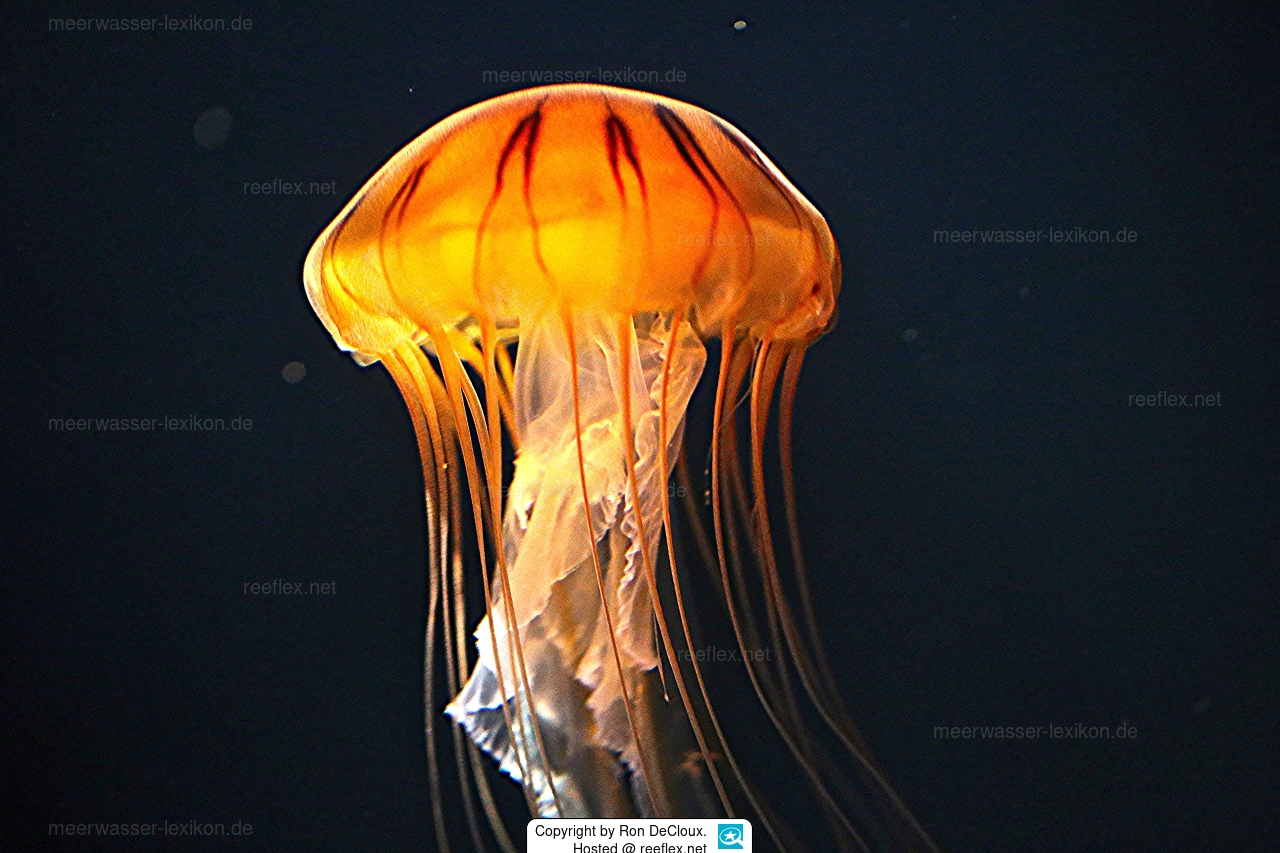Info
The bell of Chrysaora pacifica can grow up to 30.5cm and the tentacles can extend up to 300cm or more.
The bell is white with brown to orange stripes and contains up to 32 very long orange-red tentacles and four long lips.
One of the most distinctive features of Chrysaora pacifica is found on its underside, where it has 16 brown stripes and eight stomach pouches.
Like many jellyfish, Chrysaora pacifica also use stinging cells to defend themselves and stun their prey.
Although they are not particularly venomous, their stingers can cause severe skin irritation and burning in humans.
Some people can have an allergic reaction to their venom. If you see this jellyfish in the water, stay away as there is a good chance there are more of them around.
Chrysaora pacifica travels in swarms, which increases the likelihood of being stung if you encounter one of the jellyfish.
1. the life cycle begins when the males release their sperm into the water and the females collect the sperm to fertilize the eggs they have produced and hold in their mouths.
2. the fertilized eggs remain attached to the mother's mouthparts and grow into a flat, gelatinous bean-shaped planula.
3. the planula then grows into flower-shaped polyps, which are released into the ocean by the mother.
4. the polyps attach themselves to a solid surface and reproduce asexually by producing an exact copy of themselves without eggs or sperm.
The polyp produces these identical animals by budding, with the new polyp growing out of its side.
After the new polyp is fully formed, it is released into the ocean and begins to change shape to more closely resemble the adult jellyfish.
Chrysaora pacifica develops a bell, arms and tentacles until it is a fully formed medusa or adult.
The name "compass jellyfish" is derived from this ability to move in a particular direction.
Synonyms:
Chrysaora depressa (Kishinouye, 1902) - unaccepted (synonym)
Dactylometra quinquecirrha var. pacifica Goette, 1886 - unaccepted (synonym)
Kuragea depressa Kishinouye, 1902 - unaccepted (synonym)
The bell is white with brown to orange stripes and contains up to 32 very long orange-red tentacles and four long lips.
One of the most distinctive features of Chrysaora pacifica is found on its underside, where it has 16 brown stripes and eight stomach pouches.
Like many jellyfish, Chrysaora pacifica also use stinging cells to defend themselves and stun their prey.
Although they are not particularly venomous, their stingers can cause severe skin irritation and burning in humans.
Some people can have an allergic reaction to their venom. If you see this jellyfish in the water, stay away as there is a good chance there are more of them around.
Chrysaora pacifica travels in swarms, which increases the likelihood of being stung if you encounter one of the jellyfish.
1. the life cycle begins when the males release their sperm into the water and the females collect the sperm to fertilize the eggs they have produced and hold in their mouths.
2. the fertilized eggs remain attached to the mother's mouthparts and grow into a flat, gelatinous bean-shaped planula.
3. the planula then grows into flower-shaped polyps, which are released into the ocean by the mother.
4. the polyps attach themselves to a solid surface and reproduce asexually by producing an exact copy of themselves without eggs or sperm.
The polyp produces these identical animals by budding, with the new polyp growing out of its side.
After the new polyp is fully formed, it is released into the ocean and begins to change shape to more closely resemble the adult jellyfish.
Chrysaora pacifica develops a bell, arms and tentacles until it is a fully formed medusa or adult.
The name "compass jellyfish" is derived from this ability to move in a particular direction.
Synonyms:
Chrysaora depressa (Kishinouye, 1902) - unaccepted (synonym)
Dactylometra quinquecirrha var. pacifica Goette, 1886 - unaccepted (synonym)
Kuragea depressa Kishinouye, 1902 - unaccepted (synonym)







 Ron DeCloux, USA
Ron DeCloux, USA











